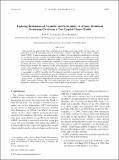Exploring Mechanisms of Variability and Predictability of Atlantic Meridional Overturning Circulation in Two Coupled Climate Models
Author(s)
Tulloch, Ross; Marshall, John C
DownloadMarshall_Exploring Mechanisms.pdf (4.223Mb)
PUBLISHER_POLICY
Publisher Policy
Article is made available in accordance with the publisher's policy and may be subject to US copyright law. Please refer to the publisher's site for terms of use.
Terms of use
Metadata
Show full item recordAbstract
Multidecadal variability in the Atlantic meridional overturning circulation (AMOC) of the ocean is diagnosed in the NCAR Community Climate System Model, version 3 (CCSM3), and the GFDL Coupled Model (CM2.1). Common diagnostic approaches are applied to draw out similarities and differences between the two models. An index of AMOC variability is defined, and the manner in which key variables covary with it is determined. In both models the following is found. (i) AMOC variability is associated with upper-ocean (top 1 km) density anomalies (dominated by temperature) on the western margin of the basin in the region of the Mann eddy with a period of about 20 years. These anomalies modulate the trajectory and strength of the North Atlantic Current. The importance of the western margin is a direct consequence of the thermal wind relation and is independent of the mechanisms that create those density anomalies. (ii) Density anomalies in this key region are part of a larger-scale pattern that propagates around the subpolar gyre and acts as a “pacemaker” of AMOC variability. (iii) The observed variability is consistent with the primary driving mechanism being stochastic wind curl forcing, with Labrador Sea convection playing a secondary role. Also, “toy models” of delayed oscillator form are fitted to power spectra of key variables and are used to infer “quality factors” (Q-factors), which characterize the bandwidth relative to the center frequency and hence AMOC predictability horizons. The two models studied here have Q-factors of around 2, suggesting that prediction is possible out to about two cycles, which is likely larger than the real AMOC.
Date issued
2012-06Department
Massachusetts Institute of Technology. Department of Earth, Atmospheric, and Planetary SciencesJournal
Journal of Climate
Publisher
American Meteorological Society
Citation
Tulloch, Ross, and John Marshall. “Exploring Mechanisms of Variability and Predictability of Atlantic Meridional Overturning Circulation in Two Coupled Climate Models.” Journal of Climate 25.12 (2012): 4067–4080. © 2012 American Meteorological Society
Version: Final published version
ISSN
0894-8755
1520-0442